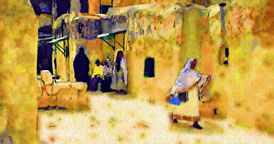Introduction
Nicodemus
Samaritan Woman
Lame man at the pool

Introduction
Nicodemus
Samaritan Woman
Lame man at the pool

Jesus asks for water. The request goes against the social and religious norms (4:9-10). What is more, the woman reasons, Jesus does not even have a drinking cup (4:11). No, she cannot give what is asked. That is, again, exactly Jesus' point: she cannot give what she does not have. Her awareness of her own inadequacies and of his sufficiency grows as the conversation continues. First, she uses polite protocol, calling him, "sir" (4:11). The second "sir"(4:15) suggests that Jesus has more status in her eyes. Perhaps "lord" would be a better translation to show her increasing respect. Then, she begins to call him "prophet" (4:19), a religious title. For the Samaritan religion the word "prophet" was significant, since Samaritans believed that a type of Moses would arise to deliver them in the last days. Nevertheless she also uses the term "Messiah" or Christ to describe the kind of knowledge Jesus is showing (4:25). Finally, Jesus discloses his own identity to her, using the highest title found in the Gospel, "I Am" (4:26).
What the reader glimpses in this private encounter is a lesson in Christology.
The woman has gone from complete ignorance about Jesus to an awareness
that takes hold of her in an immediate way. She has journeyed from deficit
to discipleship. She now goes far beyond what Nicodemus accepted in the
previous chapter. She leaves her old way of life behind, symbolized by
her water bucket left at the well, and rushes back to her city to give
her testimony to Jesus (4:39). The reader sees in this woman of Samaria
a depth of response that obviously surpasses that of Nicodemus. The reader
learns at the end of the story (4:39) that the woman's message about Jesus
opened the way for the positive response of the whole village.